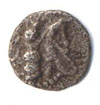

3. A history of Ephesus from coins: the Greek state
3.3 Ephesus and the Persian Empire
The last king of Lydia, Croesus, attacked Ephesus around 561 BCE, despite the fact that the Ephesians had tied a rope between the city and the temple of Artemis (whose status as an asylum was supposed to protect it). Croesus may have even moved the city to the area around the Artemision. Croesus, however, was conquered by Cyrus, king of Persia; and after that, Cyrus sent his general Harpagos to conquer Ephesus, which became part of the Persian Empire in 546 or 545.
In the sixth and fifth century, Ephesus itself, like many Greek cities, minted silver coins with its own symbol on them; in Ephesus' case, the bee ( 16 , 17 , 18 ). These coins were a valuable economic instrument, but they are also an indicator of the city's pride in its identity. Ephesus, however, was not completely autonomous; it was generally under the rule of an outside empire.
Many of the main cities of Ionia revolted from Persia in 500-494 BCE, but Ephesus stayed aloof (and escaped the consequences of revolt).

View to Artemision and Landscape of Ephesus
After the Persians lost their war with Greece in 479, however, Ephesus had to join the Delian league of Greek cities, led by Athens. The tribute lists of the various members of the league, which were inscribed on stone in Athens, show that Ephesus had to pay up to 7.5 talents in silver as its yearly contribution to the League's treasury. By 412, Ephesus leaned away from Athens and toward Athens' enemy Sparta, which had a sometime alliance with the Persian overlords (satraps) in western Asia Minor. In 410 the satrap Tissaphernes made a great sacrifice to Artemis at Ephesus, and the next year defended the city from an attack of the Athenians. In 407 Ephesus offered a harbor to a Spartan fleet led by Lysander. He soon brought Athens to its knees, but despite some pretence at Spartan leadership, from 390 on Ephesus again fell under Persian rule, and stayed there for 50 years.


